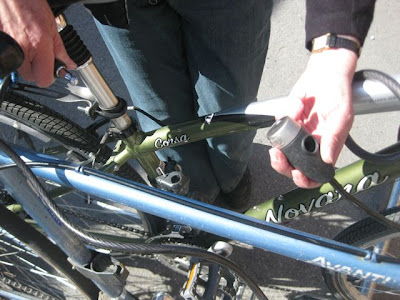As we observe the Fourth of July, it's tempting to ponder which of us would have sided with the British, which with the new American Patriots, and which would have tried to avoid taking sides and just lived their lives.
THE QUIZ APPROACH
Allthetests offers a quiz for that which begins:
But how can the typical American of 2011 honestly answer a question like that? How would you answer a question like:
If you saw a someone being robbed, would you run to help the person?
I doubt very many of us know how we would react in such a situation. Each robbery has a different context. Are there others around? Does the robber have a gun? Are we in a hurry? Have you - the bystander - been trained to fight?
So many things come into play that even if we've been in the situation before, we may not be able to predict what would happen next time. When it comes to taking personal risks, our emotional response doesn't always match our ideals.
With something as abstract as what we would have done 200 years ago, where our personal standing in that society is undefined, where the 'right' and 'wrong' answers are so known, and where all the personal emotional context is non-existent, is impossible.
THE PSYCHOLOGICAL FACTORS APPROACH
Wikipedia says that Larabee (1948) has identified eight characteristics of the Loyalists that made them essentially conservative:
* Psychologically they were older, better established, and resisted innovation.
* They felt that resistance to the Crown—the legitimate government—was morally wrong.
* They were alienated when the Patriots resorted to violence, such as burning houses and tarring and feathering.
* They wanted to take a middle-of-the road position and were angry when forced by the Patriots to declare their opposition.
* They had a long-standing sentimental attachment to Britain (often with business and family links).
* They were procrastinators who realized that independence was bound to come some day, but wanted to postpone the moment.
* They were rightly cautious and afraid of anarchy or tyranny that might come from mob rule, which did cost many their property and security after the revolution.
* Some say they were pessimists who lacked the confidence in the future displayed by the Patriots, while others point to the memory and dreadful experience of many Scottish immigrants who had already seen or paid the price of rebellion in dispossession and clearance from their prior homeland.
Could we use these to better gauge where we would have been?
- Would older folks who don't text today, have been loyalists?
- What about folks who think we need to respect the president, even if he's not always right?
- Is aversion to violence today the equivalent of aversion to the violence of Patriots in the 1700s?
- What sort of long-term sentimental attachment today would be equivalent such an attachment to Britain back then?
Wikipedia's article on Patriots offers characteristics about Patriots that seem to overlap those of Loyalists to some extent.
The Patriots came from many different backgrounds. Among the most active of the Patriots group were highly educated and fairly wealthy individuals. However, without the support of the ordinary men and women, such as farmers, lawyers, merchants, seamstresses, homemakers, shopkeepers, and ministers, the struggle for independence would have failed.
In 2000 historian Robert Calhoon estimated that in the Thirteen Colonies between 40 and 45 percent of the white population supported the Patriots' cause:
Historians' best estimates put the proportion of adult white male loyalists somewhere between 15 and 20 percent. Approximately half the colonists of European ancestry tried to avoid involvement in the struggle — some of them deliberate pacifists, others recent emigrants, and many more simple apolitical folk. The patriots received active support from perhaps 40 to 45 percent of the white populace, and at most no more than a bare majority.
Clearly, calculating those numbers, over 200 years after the fact, has lots of complications.
Are there members of current political groups who would have been more likely to Patriots or Loyalists?
Tea Party members and supporters, according to
an Atlantic article last year, made up
- 4% of the population (actual members according to a CBS/NYTimes poll) or
- 28% identified as "supporter[s] of the Tea Party movement" (Gallup poll)
- 4% (18% of the 20% supporting the Tea Party in another CBS/NYTimes poll had actually given money or attended a Tea Party event)
Those numbers were calculated a year ago, but the 28% and 20% number is vaguely close to the estimated number of Loyalists. Of course, that's a ridiculous correlation.
Do Tea Party supporters have characteristics more like those of Patriots or Loyalists?
Apparently that same CBS/NYTimes poll, this time
cited in the Dallas News, identifies a number of factors that are more associated with Tea Party supporters than the general public. [I've reorganized the list a bit to make it briefer.]
- Tea Party supporters are more likely to classify themselves as "angry." Their anger is rooted in deep pessimism about the direction of the country.
- Obama does not share the values most Americans live by, and that
- he does not understand the problems of people like them.
- More than half say administration policies favor the poor, and
- 25 percent, compared with 11 percent of the general public, think the administration favors blacks over whites.
- Tea Party supporters offered three main concerns:
- the recent health care overhaul,
- government spending and
- a feeling that their opinions are not represented in Washington.
- More than eight in 10 hold an unfavorable view of him personally, and
- 92 percent believe he is moving the country toward socialism - an opinion shared by about half the general public.
- Most describe the amount they paid in taxes this year as "fair."
- Most send their children to public schools;
- do not think Sarah Palin, who spoke at a Tea Party rally in Boston on Tuesday, is qualified to be president; and,
- despite their push for smaller government, think that Social Security and Medicare are worth the cost.
- They are actually more likely than the general public to have returned their census forms, despite some conservative leaders urging a boycott.
How would you compare this list (assuming it was even accurate a year ago) to characteristics of Patriots and Loyalists?
Even though they are named after a quintessential Patriot event, one interpretation of this list could be that many Tea Party supporters are more like the conservatives who were resisting change to the status quo. People who thought that they had something to lose from radically changing the system.
CONTEXT TODAY?
But I'm not willing to make such a conclusion. Tea Party supporters are probably a pretty varied group. And just as 'older, and better established' is listed as a Loyalist characteristic, leaders of the Patriots were also from the wealthier classes.
But, as we observe Independence Day, it's useful to question ourselves carefully about the kinds of risk we would be willing to take and under what conditions. (To what extent is risk-taking genetically inherited and to what extent is it environmentally shaped? Do people take risks in some areas, but not other areas of their lives?)
What are you willing to risk today to protect democracy?
How many of us use lack of understanding of how to effectively protect democracy as an excuse not to do something?
How many of us are working at understanding what roles we can effectively play?
How many of us would not have understood the right path back in the 18th Century? (Was there only one 'right path' or did it matter who you were. For instance many black slaves fought for the British after being promised their freedom.)
None of this is easy. But I urge you to go out and listen to someone you disagree with. Assume that the person is rational and sincere in his or her beliefs. Then ask the person to explain the position taken and how he knows he's right. (I tried hard to make that sentence work without gendered pronouns, but finally gave up.) Don't contradict. Don't challenge. Just ask, respectfully, to better understand. It's hard to do. but worth it.
Happy Fourth of July.

































